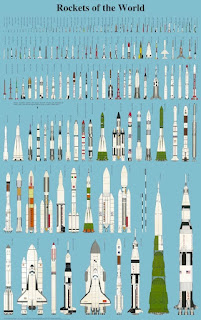Space exploration makes the use of Astronomy and space technology to explore outer space. On the one hand where the study of space is carried out mainly by astronomers with telescopes, on the other hand its physical exploration though is conducted both by advanced robotic space equipments and human spaceflights.
The observation of objects in space, known as Astronomy, as according to reliable recorded history, the development of huge and efficient rockets during the middle of the twentieth century that allowed physical space exploration became the reality. Common beliefs for exploring space include national prestige, uniting different nations, ensuring the future survival of humanity, advancing scientific research and developing military and strategic advantages against other countries.
The beginning era of space exploration was driven by the "Space Race" between the Soviet Union and the United States. The launch of the first human-made object to orbit Earth, the Soviet Union's Sputnik 1, on 4 October 1957, and then the first Moon landing by the American Apollo 11 mission on 20 July 1969 are often taken as landmarks for the initial time. Though, the Soviet space program achieved many of the first milestones like the first living being in orbit in 1957, the first human spaceflight (Yuri Gagarin aboard Vostok 1) in 1961, the first spacewalk (by Alexei Leonov) on 18 March 1965, the first automatic landing on another celestial body in 1966, and the launch of the first space station (Salyut 1) in 1971. After the initial 20 years of exploration, the interest shifted from one-off flights to renewable hardware, such as the Space Shuttle program, and from competition to cooperation as with the International Space Station (ISS).
With the stable completion of the ISS following STS-133 in March 2011, plans for space exploration by the U.S. remain in a continuous manner. Constellation, a Bush Administration program for a return to the Moon by 2020 was thought inadequately supported and unrealistic by an expert review panel reporting in 2009. In Obama's Administration a revision of Constellation is proposed in 2010 to focus on the development of the capability for crewed missions beyond Low Earth Orbit (LEO), envisioning extending the operation of the ISS beyond 2020, transferring the creation of launch vehicles for human crews from NASA to the private sector, and developing technology to enable missions beyond LEO, such as Earth–Moon L1, the Moon, Earth–Sun L2, near-Earth asteroids, and Phobos or Mars orbit.
In the 2000s, the People's Republic of China initiated a successful manned spaceflight program, while other organisations like European Union, Japan, and India have also being prepared for future crewed space missions. China, Russia, Japan, and India have stood with abd supported crewed missions to the Moon during the 21st century, while the European Union has advocated the missions to both the Moon and Mars during the 20th and 21st century.
By this manner the "Space Race" has proved to be an effective and efficient way for the development of space research and space exploration. And every country just worked too hard to hit any milestone first before rest of the all.Such as India became the first country to achieve mars orbiting in its very first attempt,the moon rover CHANDRAYAAN and many their countries put up their name in the list of the milestones.
It will be interesting and wondering to see what else can tbe space race bring in the next decade.





No comments:
Post a Comment